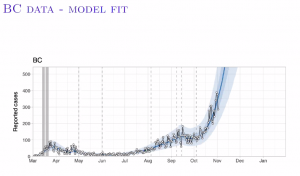Written by: Karissa Ketter, News Writer
Dr. Caroline Colijn, Dr. Jessica Stockdale, and Dr. Paul Tupper from the MAGPIE Research Group featured as the guest speakers for the November 5, 2020 Cafe Scientifique hosted on Zoom. Dr. Colijn, Dr. Stockdale, and Dr. Tupper are researchers that work on “forecasting [COVID-19] cases, estimating how well distancing measures are working or not working, and how much change we need to make to get cases back in decline,” as introduced by moderator Cynthia Henson. During the event they focused on sharing their COVID-19 data extrapolations, models, and challenges they face in their field. The Peak previously had the chance to speak with Dr. Colijn, in which she spoke on projecting trends in COVID-19 using mathematical modelling.
READ MORE: “BC’s COVID-19 health policies are being informed by SFU professor’s research”
At this event, Dr. Colijn noted the importance of analyzing the extrapolations — which estimates the growth of cases assuming nothing else will change — of where BC’s COVID-19 cases will end up if public behaviour stays constant. They noted that they prefer to analyze their models as extrapolations instead of forecasts or predictions of what the future may hold. Dr. Stockdale said as estimating public behaviour is difficult, they don’t refer to their data as forecasting because of the many factors that could influence the movement of the curve, such as change in public policies, public health orders, or a change in public behaviour.
According to Dr. Colijn, BC worked hard to flatten the curve of cases when the pandemic began. As the cases started diminishing, BC started reopening: now their data shows an extreme second wave of cases that is larger than the original wave. Dr. Tupper noted that they can “predict things about the virus, but predicting policy maker’s behavior and public behavior [is] really hard to do.”

Dr. Stockdale elaborated on some of the challenges they face when analyzing their data. Researchers need to “balance picking a model which is complicated enough that we think it’s really representing what’s happening in the real world, but also simple enough that we can be confident in our estimates and also that it’s interpretable” for the public or fellow researchers.
During the question period, some asked about the danger of asymptomatic carriers. Nearly 20–40% of adults and 40% of school-aged children are infected with COVID-19 and never develop symptoms, according to Dr. Colijn and Dr. Tupper. They added that it’s difficult to have concrete numbers, as they don’t know the rate of false-negatives. These carriers spread the virus to others in the community. Dr. Stockdale commented on the importance of physical distancing in these scenarios. She stated that “the people who are physical distancing are less likely to go out and see people, so they’re less likely to get infected [therefore] if a social distancing person does get infected, because they’re seeing others less, they’re less likely to pass on that infection.” Dr. Colijn also said that social bubbles of six people are extremely helpful in slowing the spread of the virus.
Discussion also took place around the COVID-19 cases in elementary schools. Dr. Tupper concluded that “it seems that ventilation is very important” alongside the wearing of masks and physical distancing to keep cases low. Dr. Tupper presented models that show lowered predicted COVID-19 cases when intervention and testing happens in the classroom compared to the natural flow of infection with intervention and testing. He stated the projections concluded that contact tracing and close monitoring “[reduces] the size of the cluster” by less than 50%.
Furthermore, Dr. Colijn elaborated on their future work in “[understanding] something about local transmission” and the diversity of the genome sequences found all over the globe. Her example was that if two colleague’s virus genome sequences are not similar enough then they can conclude that they haven’t infected each other. According to Dr. Colijn, they can use that data to “really improve the monitoring and control of transmission” by separating which strains are increasing and which are falling away. Dr. Colijn noted that the end idea “would be to [ . . . ] trigger action to look for strains that might be escaping a vaccine.”
Dr. Colijn further explained that “as far as we know right now, the diversity of the virus isn’t suggesting that we need different vaccines for different places” or different strains and that COVID-19 is mutating at one-third the rate the flu does.
Dr. Colijn concluded by noting that for more information she recommends watching the documentary Totally Under Control. She “found it to be like watching a very slow and fascinating trainwreck.”